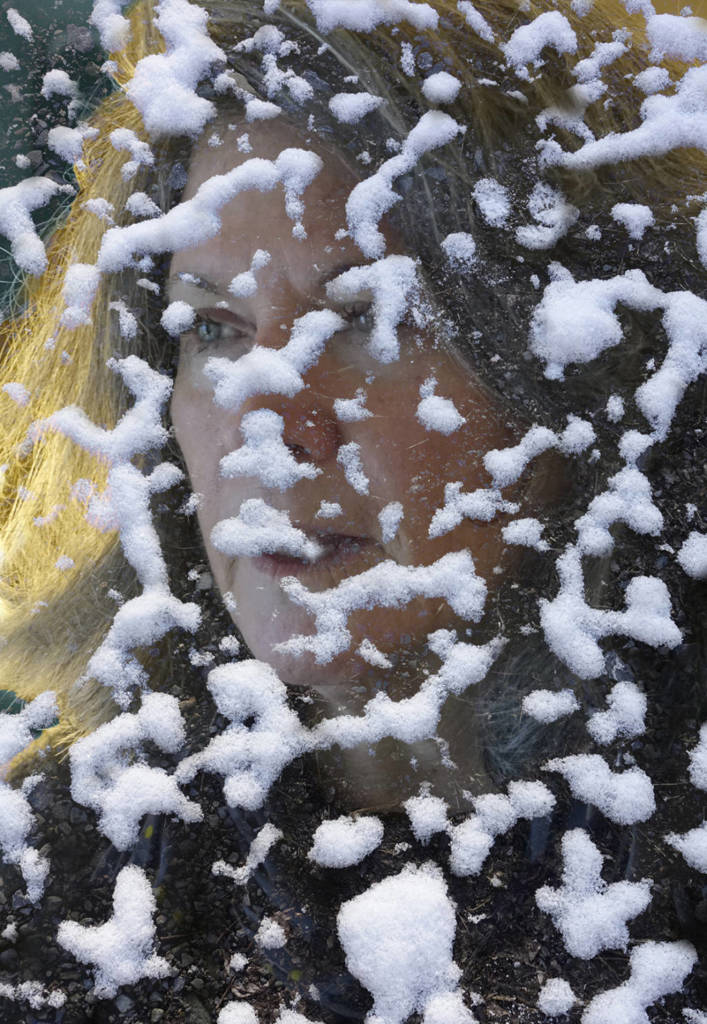 We look at things differently when we know it’s the last time. On an early morning last week, my driveway was exquisitely patterned with bright patches of snow. The last snow of the season, I thought as I photographed it and then photo-shopped it to veil a portrait of the death midwife who patiently waits for and watches the last moments of life.
We look at things differently when we know it’s the last time. On an early morning last week, my driveway was exquisitely patterned with bright patches of snow. The last snow of the season, I thought as I photographed it and then photo-shopped it to veil a portrait of the death midwife who patiently waits for and watches the last moments of life.
“What does a death midwife do?” I asked Iona (a name I chose for her after we spoke).
“…hold a conscious awareness of the naturalness of death. Sit vigil at the deathbed—holding space and bearing witness. Provide accompaniment, non-medical support, and education for the dying and their loved ones in the final months, weeks and days of life,” she answered. “Holding space,” she said, several times. I had to look that term up. It means to make oneself entirely, wholeheartedly present to someone, offering unconditional, non-judgmental support.
Iona told me the story of the first person she sat with. It was a woman with end-stage Alzheimer’s who talked constantly but incoherently. For six weeks Iona visited her and listened without understanding a word, until one day, at the very end, in a moment of clarity the woman said, clear as a bell, “Those of us with wings can fly away now.”
“What did you lose and what did you find?” I asked her, because I always pose this question.
“When I do this work, all judgment falls away. It is such a relief to stand in a space that is completely neutral…there’s nothing to do, you’re just asked to be. It lets me be a kinder, gentler version of myself. I found my true calling.”
“What have you learned from sitting with the dying?” I asked finally.
“That one is living until one is dead. There is always a possibility of growth and transformation up ‘til the last moment,” she said, and “You die the way you lived.” Which gave me a lot to think about.
If you die the way you live, what changes might you want to make while there is still time? What would your own dying look like, how would you want to die?
Please Share on your Social Media
Oh, yes. So beautiful. My favorite people at hospice are the ones who spend much time sitting with and being with the dying. It amazes me that we have volunteers who sit vigil for those who don’t have families to sit with them–and even those who do. It amazes me the kindness we can show each other by simply being there. Thank you, Robin. Getting rid of self-judgment seems to be a life-time task for most of us.
I would like to stop judging myself so harshly, or on my deathbed I’ll be mumbling, “Why didn’t I prepare better for this? Why did I waste so much time? Why didn’t I etc., etc., etc. . . . .
Thanks for a beautiful post!
You and I are twins in that way, Lynne. I wonder if the midwife has heard this time and time again. I guess that’s what Death Cafes are all about. More opportunity to explore what we’re in for and how (or why) to make the most of what we have right now. Thanks for being here.
Oh my, Robin, quite the provocative question … if you die the way you live…I can probably journal on this for a week. The death midwife’s experience is intriguing and so generous. Thank you for asking the best questions.
I think that’s the question we all need to explore in order to really do a good job of this thing called ‘living.’ A lifetime’s worth of journaling, maybe.